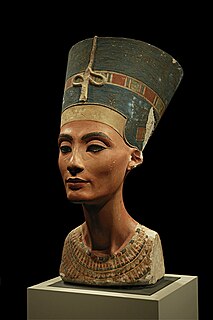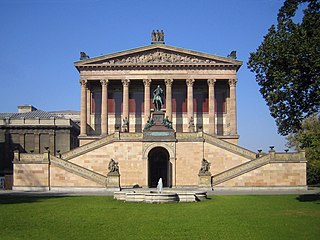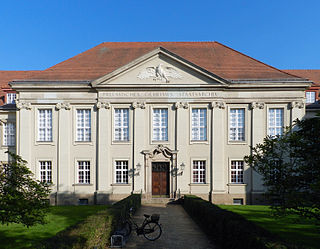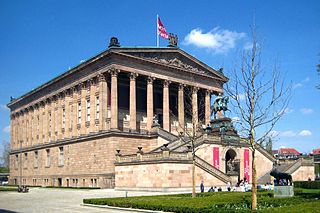Related Research Articles

The conservation and restoration of cultural heritage focuses on protection and care of tangible cultural heritage, including artworks, architecture, archaeology, and museum collections. Conservation activities include preventive conservation, examination, documentation, research, treatment, and education. This field is closely allied with conservation science, curators and registrars.

The Egyptian Museum of Berlin is home to one of the world's most important collections of Ancient Egyptian artifacts, including the iconic Nefertiti Bust. Since 1855, the collection is a part of the Neues Museum on Berlin's Museum Island, which reopened after renovations in 2009.

The Altes Museum is a listed building on the Museum Island in the historic centre of Berlin and part of the UNESCO World Heritage. Built from 1825 to 1830 by order of King Frederick William III of Prussia according to plans by Karl Friedrich Schinkel, it is considered as a major work of German Neoclassical architecture. It is surrounded by the Berlin Cathedral to the east, the Berlin Palace to the south and the Zeughaus to the west. Currently, the Altes Museum is home to the Antikensammlung and parts of the Münzkabinett.

The Berlin State Library is a universal library in Berlin, Germany and a property of the Prussian Cultural Heritage Foundation. It is one of the largest libraries in Europe, and one of the most important academic research libraries in the German-speaking world. It collects texts, media and cultural works from all fields in all languages, from all time periods and all countries of the world, which are of interest for academic and research purposes. Some famous items in its collection include the oldest biblical illustrations in the fifth-century Quedlinburg Itala fragment, a Gutenberg Bible, the main autograph collection of Goethe, the world's largest collection of Johann Sebastian Bach's and Wolfgang Amadeus Mozart's manuscripts, and the original score of Ludwig van Beethoven's Symphony No. 9.

The Gemäldegalerie is an art museum in Berlin, Germany, and the museum where the main selection of paintings belonging to the Berlin State Museums is displayed. It holds one of the world's leading collections of European paintings from the 13th to the 18th centuries. Its collection includes masterpieces from such artists as Albrecht Dürer, Lucas Cranach, Hans Holbein, Rogier van der Weyden, Jan van Eyck, Raphael, Botticelli, Titian, Caravaggio, Giambattista Pittoni, Peter Paul Rubens, David Teniers the Younger, Rembrandt, Johannes Vermeer, and Antonio Viviani. It was first opened in 1830, and the current building was completed in 1998. It is located in the Kulturforum museum district west of Potsdamer Platz.

The Alte Nationalgalerie is a listed building on the Museum Island in the historic centre of Berlin and part of the UNESCO World Heritage. It was built from 1862 to 1876 by order of King Frederick William IV of Prussia according to plans by Friedrich August Stüler and Johann Heinrich Strack in Neoclassical and Renaissance Revival styles. The building's outside stair is adorned with a memorial to Frederick William IV. Currently, the Alte Nationalgalerie is home to paintings and sculptures of the 19th century.

The Museum of Asian Art is located in the Dahlem neighborhood of the borough of Steglitz-Zehlendorf, Berlin, Germany. It is one of the Berlin State Museums institutions and is funded by the Prussian Cultural Heritage Foundation. It houses some 20,000 Asian artifacts, making it one of the largest museums of ancient Asian art in the world. The museum is located in the same building as the Ethnological Museum of Berlin. The museum houses important collections of Art houses of South, Southeast and Central Asian countries and art from the Indo-Asian cultural area, from the 4th millennium BC to the present. Its geographic reach covers regions in India, Pakistan, Afghanistan, Sri Lanka, Bangladesh, Nepal, the Autonomous Region of Tibet and Xinjiang of the People's Republic of China, the Southeast Asian countries of Myanmar, Thailand, Cambodia, Vietnam, and also the Indonesian Islands or archipelago.

Friedrich August Stüler was an influential Prussian architect and builder. His masterpiece is the Neues Museum in Berlin, as well as the dome of the triumphal arch of the main portal of the Berliner Stadtschloss.

The Prussian Academy of Arts was a state arts academy first established in Berlin, Brandenburg, in 1694/1696 by prince-elector Frederick III, in personal union Duke Frederick I of Prussia, and later king in Prussia.
The Prussian Cultural Heritage Foundation, headquartered in Berlin, Germany, was established in 1957 by German Federal law with the mission to acquire and preserve the cultural legacy of the former State of Prussia. Its purview encompasses over 27 institutions, including all of Berlin's State-run Museums, the Berlin State Library, the Prussian Privy State Archives and a variety of institutes and research centers. As such it has become one of largest cultural organizations in the world. As of 2020, it is also the largest cultural employer in Germany with around 2,000 employees and a 2020 budget of 336 million euros.

The Berlin State Museums are a group of institutions in Berlin, Germany, comprising seventeen museums in five clusters, several research institutes, libraries, and supporting facilities. They are overseen by the Prussian Cultural Heritage Foundation and funded by the German federal government in collaboration with Germany's federal states. The central complex on Museum Island was added to the UNESCO list of World Heritage Sites in 1999. By 2007 the Berlin State Museums had grown into the largest complex of museums in Europe.

Heiko Daxl was a German media artist, exhibition curator, art gallery owner and design / art collector. Born in Oldenburg, Germany, he lived and worked in Berlin and Zagreb.

The Berliner Phonogramm-Archiv is a collection of ethnomusicological recordings or world music, mostly on phonographic cylinders, assembled since 1900 in Berlin, Germany by the institution of the same name.

The Ethnological Museum of Berlin is one of the Berlin State Museums, the de facto national collection of the Federal Republic of Germany. It is presently located in the museum complex in Dahlem, along with the Museum of Asian Art and the Museum of European Cultures. The museum holds more than 500,000 objects and is one of the largest and most important collections of works of art and culture from outside Europe in the world. Its highlights include important objects from the Sepik River, Hawaii, the Kingdom of Benin, Cameroon, Congo, Tanzania, China, the Pacific Coast of North America, Mesoamerica, the Andes, as well as one of the first ethnomusicology collections of sound recordings

The Museum of European Cultures - National Museums in Berlin - Prussian Cultural Heritage Foundation came from the unification of the Europe-Department in the Berlin Museum of Ethnography and the Berlin Museum for Folklore in 1999. The museum focuses on the lived-in world of Europe and European culture contact, predominantly in Germany from the 18th Century until today.

Schloss Köpenick is a Baroque water palace of the Hohenzollern electors of Brandenburg which stands on an island in the Dahme River surrounded by an English-style park and gives its name to Köpenick, a district of Berlin.
The Ibero-American Institute or IAI is an interdisciplinary institution located in Berlin, Germany for academic and cultural exchange between Germany and Latin America, Spain, Portugal and the Caribbean. It is the largest non-university research center for Latin American Studies outside of Latin America. It also features the largest specialized library in Europe on Latin America, Spain, Portugal and the Caribbean. In addition to a large rare book collection, the IAI collects and preserves magazines, electronic documents, maps, audio media, photographs, videos, DVDs, papers and diverse additional materials. The IAI is a member of the Research Association CEISAL and the documentation network association REDIAL. Founded in 1930, since 1962 the IAI has been an agency of the Prussian Cultural Heritage Foundation. It is located at the Kulturforum near Potsdamer Platz in Berlin-Mitte.

The Secret State Archives Prussian Cultural Heritage Foundation is an agency of the Prussian Cultural Heritage Foundation headquartered in Berlin, Germany. A Federal statutory body, it is one of the largest repositories of primary source documents in Germany and spans the history of Prussia, Brandenburg, the House of Hohenzollern and the Prussian Army. Insofar as the agency represents over 400 years of archival work of the former states of Brandenburg-Prussia, including their main roots in the Teutonic Knights, the Archives can be said to cover "nine centuries of European history between Königsberg and Cleves."

The National Gallery in Berlin, Germany, is a museum for art of the 19th, 20th and 21st centuries. It is part of the Berlin State Museums. From the Alte Nationalgalerie, which was built for it and opened in 1876, its exhibition space has expanded to include five other locations. The museums are part of the Berlin State Museums, owned by the Prussian Cultural Heritage Foundation.

The Kronprinzenpalais is a former Royal Prussian residence on Unter den Linden boulevard in the historic centre of Berlin. It was built in 1663 and renovated in 1857 according to plans by Heinrich Strack in Neoclassical style. From 1919 to 1937, it was home to the modern art collection of the National Gallery. Damaged during the Allied bombing in World War II, the Kronprinzenpalais was rebuilt from 1968 to 1970 by Richard Paulick as part of the Forum Fridericianum. In 1990, the German Reunification Treaty was signed in the listed building. Since then, it has been used for events and exhibitions.
References
- ↑ "Werner Kittel Archive" (in German). Archived from the original on 2013-03-22. Retrieved 2012-02-04.
- ↑ "Staatliche Museen zu Berlin >> Zentralarchiv" [Central Archive] (in German). Archived from the original on 2010-12-21. Retrieved 2012-02-04.